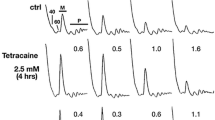Summary
Oligomycin, an inhibitor of ATP synthesis, has been used as a model to study the effects of ATP depletion on macromolecular synthesis and modification of membrane permeability. Protein synthesis is totally blocked by the antibiotic, whereas RNA and DNA synthesis are less inhibited. Different concentrations of monovalent and divalent cations do not revert the inhibition of protein synthesis. Measurement of cellular ATP and 86Rb+ content indicate that the blockade of translation depends on the ATP content. A significant decrease in cellular ATP does not lead to the reduction of monovalent ions in the cell, although hyperpolarization of the cell membrane does take place. An increased membrane permeability to some inhibitors develops when the cells are hyperpolarized by oligomycin.
Similar content being viewed by others
References
Revel M, Groner Y: Post-transcriptional and translational controls of gene expression in eukaryotes. Ann Rev Biochem 47:1079–1126,1978.
Lubin M: Intracellular potassium and macromolecular synthesis in mammalian cells. Nature 213:451–453, 1967.
Ledbetter MLS, Lubin M: Control of protein synthesis in human fibroblasts by intracellular potassium. Exp Cell Res 105:223–236,1977.
Alonso M, Carrasco L: Relationship between membrane permeability and the translation capacity of human HeLa cells studied by means of the ionophore nigericin. Eur J Biochem 118:289–294,1981.
Carrasco L, Smith AE: Sodium ions and the shut-off of host cell protein synthesis by picornaviruses. Nature 264:807–809, 1976.
Garry RF, Bishop JM, Parker S, Westbrook K, Lewis G, Waite MRF: Na+ and K+ concentrations and the regulation of protein synthesis in Sindbis virus-infected cells. Virology 99:179–182,1979.
Lacal JC, Carrasco L: Relationship between membrane integrity and the inhibition of host translation in virus-infected mammalian cells. Comparative studies between encephalomyocarditis virus and poliovirus. Eur J Biochem 127: 359–366,1982.
Alonso MA, Carrasco L: Reversion by hypotonic medium of the shut-off of protein synthesis induced by encephalomyocarditis virus. J Virol 37:535–540, 1981.
Alonso MA, Carrasco L: Permeabilization of mammalian cells to proteins by the ionophore nigericin. FEBS Lett 127:112–114,1981.
Alonso MA, Carrasco L: Molecular basis of the permeabilization of mammalian cells by ionophores. Eur J Biochem 127:567–569,1982.
Fernandez-Puentes C, Carrasco L: Viral infection permeabilized mammalian cells to protein toxins. Cell 20:769–775, 1980.
Carrasco L, Lacal JC: Permeabilization of cells by animal virus infection. Pharmacol Ther 23:109–145, 1983.
Nicholls DG: Bioenergetics. An Introduction to the Chemiosmotic Theory. Academic Press, 1982.
Stanley PE, Williams SG: Use of the liquid scintillation spectrometer for determining adenosine triphosphate by the luciferase enzyme. Anal Biochem 29:381–392, 1969.
Vázquez D: Inhibitors of protein biosynthesis. Mol Biol Biochem Biophys Vol 30. Springer-Verlag, 1979.
Carrasco L, Vázquez D: Viral translation inhibitors. In: Antibiotics Vol VI. Springer-Verlag, 1983, pp. 282–295.
Rozengurt E, Heppel LA: Reciprocal control of membrane permeability of transformed cultures of mouse cell lines by external and internal ATP. J Biol Chem 254:708–714, 1979.
Alonso MA, Carrasco L: Action of membrane-active compounds on mammalian cells. Permeabilization of human cells by ionophores to inhibitors of translation and transcription. Eur J Biochem 109:535–540, 1980.
Carrasco L, Smith AE: Molecular biology of animal virus infection. Pharmacol Ther 9:311–355, 1980.
Lichsthein D, Dunlop K, Kaback HR, Blume AJ: Mechanism of monensin-induced hyperpolarization of neuroblastoma-glioma hybrid NG 108–15. Proc Natl Acad Sci USA 76:2580–2584,1979.
Author information
Authors and Affiliations
Rights and permissions
About this article
Cite this article
Jesús Otero, M., Carrasco, L. Action of oligomycin on cultured mammalian cells. Permeabilization to translation inhibitors. Mol Cell Biochem 61, 183–191 (1984). https://doi.org/10.1007/BF00222495
Revised:
Issue Date:
DOI: https://doi.org/10.1007/BF00222495




